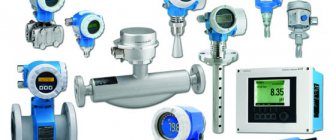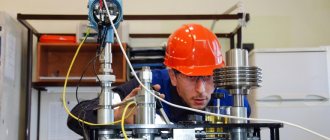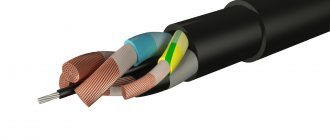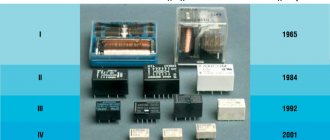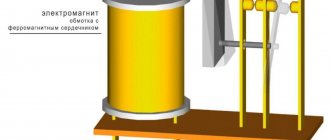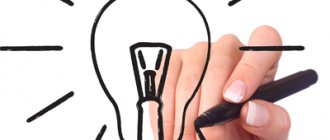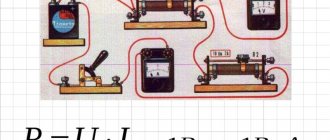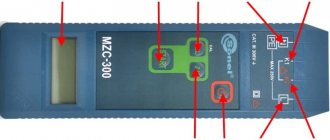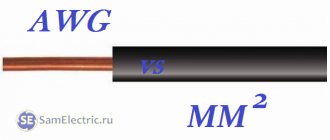A large amount of modern technological equipment is automated. These are pumping stations, boiler houses, power supply systems, and technological equipment. Process automation is often performed using microcontroller control circuits. But data collection for them is carried out by instruments and measuring sensors. Maintenance, repair, installation and adjustment of these devices is carried out by highly qualified specialists.
Classification of instrumentation
The abbreviation instrumentation refers to devices used not only in production, but also in other types of human activity - in science, healthcare and everyday life. All control and measuring instruments can be divided:
- by purpose (showing in place and recording);
- if possible, remote transmission of measured readings;
- by type of indication (analog, discrete, digital);
- by accuracy class;
- according to measured physical and chemical parameters (temperature, pressure, flow, level, concentration, humidity and density, electrical quantities, etc.).
Let's look at some devices that are divided depending on the parameters being measured:
- Instruments for measuring temperature - thermometers, thermometers, thermocouples, resistance thermometers, thermal imagers and pyrometers. Devices are digital, fluidic, electrical, electronic, infrared, contact and non-contact.
- Sensors for determining pressure - pressure gauges, pressure switches, analog pressure sensors and vacuum gauges. Pressure gauges vary in design - membrane, differential, electric contact, spring. An electrical analog signal when measuring pressure is usually obtained due to the tensoelectric effect - the property of solid materials to change their electrical resistance when deformed.
- Devices for measuring the volume of flow of a working medium (liquid, gas or other substances passing per unit of time) - flow meters. Depending on the principle of operation, the devices are electromagnetic, ultrasonic, including non-contact overhead, vortex, having various narrowing devices such as a diaphragm, tachometer and others.
- Devices for determining the concentration of certain substances in gas mixtures - gas analyzers, smoke analyzers, pH meters and steam analyzers. There are manual and automatic, stationary and portable. These devices are used to monitor air in the work area, to check industrial emissions, to monitor technological processes, to monitor gaseous media leaks, and to ensure fire safety.
- Tank filling level meters - level gauges. Used to measure the level of liquid and bulk materials in tanks, containers and storage facilities. Level gauges can be contact and non-contact, for example, buoy or float gauges, hydrostatic, ultrasonic, radar, interface level gauges, bubbling and other types.
- Instruments for measuring linear quantities. Rulers, tape measures, calipers, gauges, micrometers, depth gauges, etc.
- Instruments for measuring electrical energy parameters. Ammeters, voltmeters, ohmmeters, wattmeters, multimeters, etc.
- Instruments that measure radiation. These include Geiger counters, dosimeters and detectors.
- Instruments for measuring mass, hardness and density of materials. These are analytical and physical scales, hardness testers.
- Tensile, compression and torque sensors.
Maintenance of instrumentation and measuring instruments
Maintenance and repair of instrumentation and automation includes all technical activities, except for work related to the introduction of new and replacement of obsolete instrumentation equipment, which are divided into unscheduled and scheduled preventive work.
Unscheduled work mainly comes down to operational repairs or replacement of failed measuring and automation equipment.
Planned maintenance work consists of:
- technical maintenance (TO);
- current repair (TR);
- major repairs (CR);
- verification/calibration of measuring instruments.
Maintenance of instrumentation and automation includes the following types of work:
- Technical inspection (external inspection, cleaning of dust and residues of technological products, inspection, cleaning and tightening of terminals, inspection of kinematics and its lubrication, checking the tightness of the connection of pipe lines and the serviceability of remote data transmission devices, the safety of pipes);
- Functionality check, checking by control points (set to “zero”), identification and elimination of minor defects that arose during operation;
- Replacing diagrams, cleaning recorders and refilling them with ink, lubricating movement mechanisms, filling or replacing special fluids, eliminating their leaks;
- Checking the operation of automation equipment in the event that a discrepancy is detected during the process mode and the readings of measuring instruments;
- Washing measuring chambers, correcting seals and fasteners, checking selected pressure and flow devices, drying elements of measuring and automation equipment and cleaning contacts;
- Removal of measuring and automation equipment for repairs and timely submission of them for inspection;
- Checking power supplies, indicating and recording units of measuring instruments for analyzing the composition and properties of substances and materials;
- Cleaning, lubricating and checking relays, sensors, actuators, regulators of all systems and purposes, checking for tightness and tightness of impulse and connecting lines, replacing faulty individual elements and assemblies, testing them in operation;
- Checking the availability of power (electrical, pneumatic, etc.), its quality parameters in control, alarm, blocking and protection circuits, testing sound and light alarms;
- Checking the operation of circuits and the correctness of settings for their operation and other checks related to the features of specific circuits;
- Inspection of automation panels, interlocking devices, alarm and protection equipment.
Maintenance work is carried out by the personnel of the enterprise and contractors. Individual operations can be carried out by operational (technical) personnel. Maintenance work on automation equipment is carried out by personnel together with the mechanical and power engineering services.
Stopping of technological equipment can be emergency or planned.
During an emergency stop, they perform work that cannot be performed during operation of the equipment. In this case, those components of automation equipment whose serviceability was in doubt during the operation of process equipment are subject to maintenance and repair.
During a planned shutdown after a shutdown, those measuring and automation equipment, cable and pipe lines that are located near the process equipment and may be damaged during its repair are dismantled.
Repairs are carried out by specialized organizations that have: a registration certificate for the right to repair measuring instruments, issued by Gosstandart authorities; verification means (model and auxiliary measuring instruments, fixtures, devices, etc.); personnel trained and authorized to carry out repairs and verification; necessary regulatory and technical documentation, verification diagrams; premises that ensure proper repair and verification in accordance with regulatory requirements.
Verification of measuring instruments (from the Order of the Ministry of Industry and Trade dated July 2, 2015 No. 1815): Chapter III. SI verification:
- Measurements of an approved type, not intended for use in the field of state regulation of ensuring the uniformity of measurements, can be subject to verification on a voluntary basis.
- The verification results are valid during the verification interval.
- The validity period for the results of verification of measuring instruments is established: for measuring instruments for which a verification certificate with an applied verification mark is issued - until the date specified in the certificate of verification of the measuring instruments; for measuring instruments on which a verification mark is applied, but a verification certificate with the verification mark applied is not issued:
- a) for a verification mark indicating the month of verification - until the end of the month preceding the month of verification, taking into account the verification interval;
- b) for a verification mark indicating the quarter of verification - until the end of the quarter preceding the quarter of verification, taking into account the verification interval;
- c) for a verification mark indicating only the year of verification - until December 31 of the year preceding the year of verification, taking into account the verification interval.
- It is allowed to carry out initial verification of measuring instruments of the same type upon release from production before commissioning on the basis of a sample, if this is established by the verification methodology.
- It is allowed to carry out verification of individual measuring channels and (or) individual autonomous units from the measuring instrument in accordance with the application of the owner of the measuring instrument, with the obligatory indication in the verification certificate of information about the scope of the verification performed, if this is established by the verification methodology.
- Verification can be carried out at control and verification points at manufacturers of measuring instruments and organizations that repair measuring instruments. Checkpoints are organized by accredited legal entities or individual entrepreneurs.
- Each copy of the measuring instrument in operation is subject to periodic verification at an established verification interval. Instruments that have been put into operation and are in long-term storage (more than one calibration interval) are subject to periodic verification only after the end of storage. Periodic verification of measuring instruments intended for measurements (reproduction) of several quantities or having several measurement subranges, but used for measurements (reproduction) of a smaller number of quantities or on a smaller number of measurement subranges, is allowed on the basis of a written application from the owner of the measuring instrument, drawn up in any form, provided availability of appropriate instructions in the verification procedure. The corresponding entry must be made in the verification certificate and (or) in the passport (form), if this is allowed by the design of the measuring instrument.
- On a voluntary basis, owners of measuring instruments can submit measuring instruments for periodic verification more often than the established verification interval. Mandatory submission of measuring instruments for periodic verification more often than the established verification interval (extraordinary verification) is carried out, including in cases of: non-compliance of the verification mark with the forms given in Appendix 3 to this Procedure (verification marks are considered damaged if the information printed on them cannot be read without the use of special funds. Damaged verification marks cannot be restored); damage to the seal (seals are considered damaged if the information printed on them cannot be read without the use of special means and if the seals do not prevent access to adjustment units and (or) structural elements of the measuring instrument); carrying out repeated adjustment or tuning, with the opening of seals that prevent access to adjustment units and (or) structural elements, known or suspected impact or other impact, or if there are doubts about its readings.
- If a verification certificate was issued on the SI and (or) a verification mark was applied to the passport (form), then in case of loss of the verification certificate and (or) passport (form) on the SI, a duplicate of the verification certificate is issued with the mark “Duplicate” in one copy. The duplicate is drawn up in accordance with the form of the verification certificate given in Appendices 1 and 1a to this Procedure, in one copy marked “Duplicate” (indicated in the upper right corner). The verification date on the duplicate must correspond to the verification date indicated on the lost verification certificate.
- When putting an instrument into operation after long-term storage (more than one calibration interval), periodic verification is carried out.
Automation elements
In automated process control systems (APCS), various actuators are used to control the technological process.
Actuators are an element of an automatic system that acts on a control object to perform some action. Typically, actuators consist of two parts - an actuator and a regulator. The main purpose of actuators is to convert any signal (electrical, mechanical, optical, pneumatic) into signals to influence control elements (turning on, off, switching operating modes of mechanisms, systems or devices).
The most common actuators are switching relays, drives of moving parts, rotary devices, manipulators, electromagnetic valves (solenoids), devices for opening or closing control and shut-off valves and flaps, turning on variators and switching gearboxes.
Functions and tasks of instrumentation and automation specialists
The functions of the instrumentation and control department specialists are to ensure the operability and accuracy of the readings of all instrumentation and automated systems of the enterprise. The tasks of this department include monitoring the operation, adjustment and maintenance, repair and restoration of devices.
In the event of equipment failure, the Kipovets must react in a timely manner and replace the failed unit. The mechanic must conduct an inspection and, if possible, repair it within the department or at a specialized service organization. To do this, the instrumentation and control department must have spare parts, instruments and tools. Specialists of this department must conduct metrological supervision of measuring instruments to ensure the operation of all equipment. The instrumentation and control department belongs to the technical service of the enterprise and is functionally subordinate to the chief engineer.
Main activities when servicing boiler room automation
Diagnostic inspections and preventive checks make it possible to significantly extend the life of gas and boiler equipment. Employees of ENERGY & CO LLC perform:
- checking the serviceability of heat and gas instrumentation, control systems and adjustment of equipment parameters;
- checking the boiler room automation for compliance with the specified parameters;
- inspection of the condition of instrument housings, boiler equipment covers and insulation;
- setting up the operation of control sensors and adjusting them if the parameters do not correspond to the specified ones;
- checking the integrity of connections between individual elements of gas equipment;
- sending security system signals to the control room to monitor feedback.
As part of the maintenance of boiler room automation, the specifics of the building and the operating modes of the installations are taken into account. The timing of verification of devices is also monitored; if necessary, they are removed and sent to the metrological service.
Dismantling of individual devices during instrumentation and control equipment maintenance from their regular places and safe transportation to the verification point and back is carried out by qualified personnel of ENERGY and CO LLC.
Key specialists of the instrumentation and control department
At manufacturing enterprises, there are workshops or departments of instrumentation and automation. This service is led by the head of the department or workshop, sometimes these responsibilities are assigned to the chief metrologist of the enterprise. Instrumentation and control departments often include control and measurement laboratories (KIL). Depending on the type of production activity of the enterprise, the staff of the instrumentation and automation department also depends. But there is a minimum set of necessary specialists, these are:
- instrumentation engineer;
- instrument adjustment and repair technician;
- adjuster of instruments, equipment and automated accounting systems;
- mechanic for repair and adjustment of instrumentation and automation;
- electrical technician;
- radio electronic engineer;
For the efficient, safe functioning of modern engineering communications systems, it is necessary to provide these complex engineering complexes with specialized management and control tools and perform their high-quality installation.
Installation of bales and automation
To install such equipment, it is necessary to have various components: 1. Sensors, measuring instruments, actuators that monitor and control the functioning of mechanical components of the equipment;
2. Controllers that collect information from sensors that control actuators. Using algorithms, they ensure the maintenance of parameters and safe operation of equipment;
3. Means of feedback to the operator through user terminals or building management systems. For this purpose, communication gateways are used. Our specialists install bales and automation, regardless of their complexity. Installation of panels and systems is carried out according to the Customer’s designs, or according to projects developed by our specialists based on the Customer’s technical specifications.
Installation of automation systems will provide:
— Monitoring/control of the operation of units included in the equipment of air conditioning, heating, ventilation, etc. systems; — Indication of the equipment status in operating mode; — Equipment protection from supply voltage connection errors, short circuits, overheating; — Support and regulation of the desired air temperature; — Monitoring the working condition of air filters; — Independent ventilation system control algorithm; — Uninterrupted maintenance of operating equipment; — Supervisory control/management of basic parameters.
Cable system installation
The key to reliable operation of the cable system, which includes power supply, security, and communications, is its high-quality installation. Moreover, the requirements for the reliability of cable systems, their operational safety, and functionality are constantly growing. This is due to the development of modern technologies and the emergence of new high-tech materials.
It is difficult to imagine a modern building without a lighting and uninterruptible power supply control system, without local computer networks, conferencing, security systems and other communications. Other important life support systems of the building depend on the functioning of the cable infrastructure. Ultimately, this is an indicator of the degree of its comfort and functionality.
Carrying out an integrated approach to the process of installing power and low-current networks, our specialists optimize the routes for laying cable systems, taking into account the electromagnetic compatibility of the equipment. As a result, the reliability of the system increases, its maintenance is simplified, and savings in money and time are achieved.
Such results make our services competitive and in demand. The company carries out the full range of work on installation of automation, in detailed accordance with the project, as well as current state standards.
Our specialists will flawlessly install systems for power supply, energy metering, security and fire alarms, access control and management, conference calls, telephone networks, dispatch communications, parking management, etc.
We install bales and automation with high quality, professionally, in the shortest possible time, at a price convenient for our customers.
